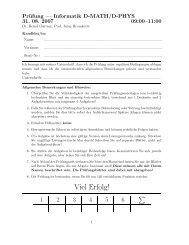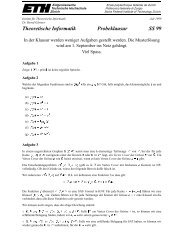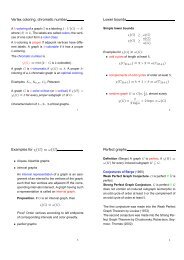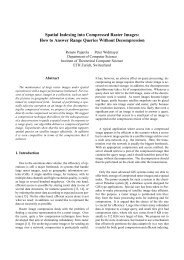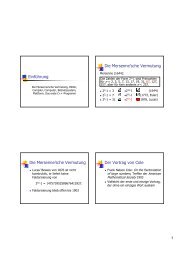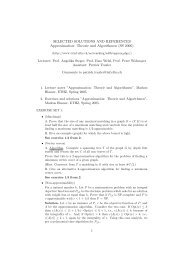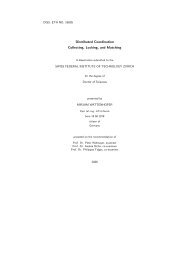Chapter 4 Line Sweep - TI
Chapter 4 Line Sweep - TI
Chapter 4 Line Sweep - TI
You also want an ePaper? Increase the reach of your titles
YUMPU automatically turns print PDFs into web optimized ePapers that Google loves.
<strong>Chapter</strong> 4. <strong>Line</strong> <strong>Sweep</strong> CG 2012<br />
intersections that are to the left of the current (moving) point. A point can be regarded<br />
a hyperplane inR 1 , and the corresponding object inR 2 is a line.<br />
General idea. Move a line ℓ (so-called sweep line) from left to right over the plane, such<br />
that at any point during this process all intersections to the left of ℓ have been reported.<br />
<strong>Sweep</strong> line status. The list of intervals containing the current point corresponds to a list L<br />
of segments (sorted by y-coordinate) that intersect the current sweep line ℓ. This list L is<br />
called sweep line status (SLS). Considering the situation locally around L, it is obvious<br />
that only segments that are adjacent in L can intersect each other. This observation<br />
allows to reduce the overall number of intersection tests, as we will see. In order to<br />
allow for efficient insertion and removal of segments, the SLS is usually implemented as<br />
a balanced binary search tree.<br />
Event points. The order of segments in SLS can change at certain points only: whenever<br />
the sweep line moves over a segment endpoint or a point of intersection of two segments<br />
from S. Such a point is referred to as an event point (EP) of the sweep. Therefore we<br />
can reduce the conceptually continuous process of moving the sweep line over the plane<br />
to a discrete process that moves the line from EP to EP. This discretization allows for<br />
an efficient computation.<br />
At any EP several events can happen simultaneously: several segments can start<br />
and/or end and at the same point a couple of other segments can intersect. In fact<br />
the sweep line does not even make a difference between any two event points that have<br />
the same x-coordinate. To properly resolve the order of processing, EPs are considered<br />
in lexicographic order and wherever several events happen at a single point, these are<br />
considered simultaneously as a single EP. In this light, the sweep line is actually not a<br />
line but an infinitesimal step function (see Figure 4.1).<br />
Event point schedule. In contrast to the one-dimensional situation, in the plane not all<br />
EP are known in advance because the points of intersection are discovered during the<br />
algorithm only. In order to be able to determine the next EP at any time, we use a<br />
priority queue data structure, the so-called event point schedule (EPS).<br />
Along with every EP p store a list end(p) of all segments that end at p, a list begin(p)<br />
of all segments that begin at p, and a list int(p) of all segments in SLS that intersect at<br />
p a segment that is adjacent to it in SLS.<br />
Along with every segment we store pointers to all its appearances in an int(¡) list of<br />
some EP. As a segment appears in such a list only if it intersects one of its neighbors<br />
32



